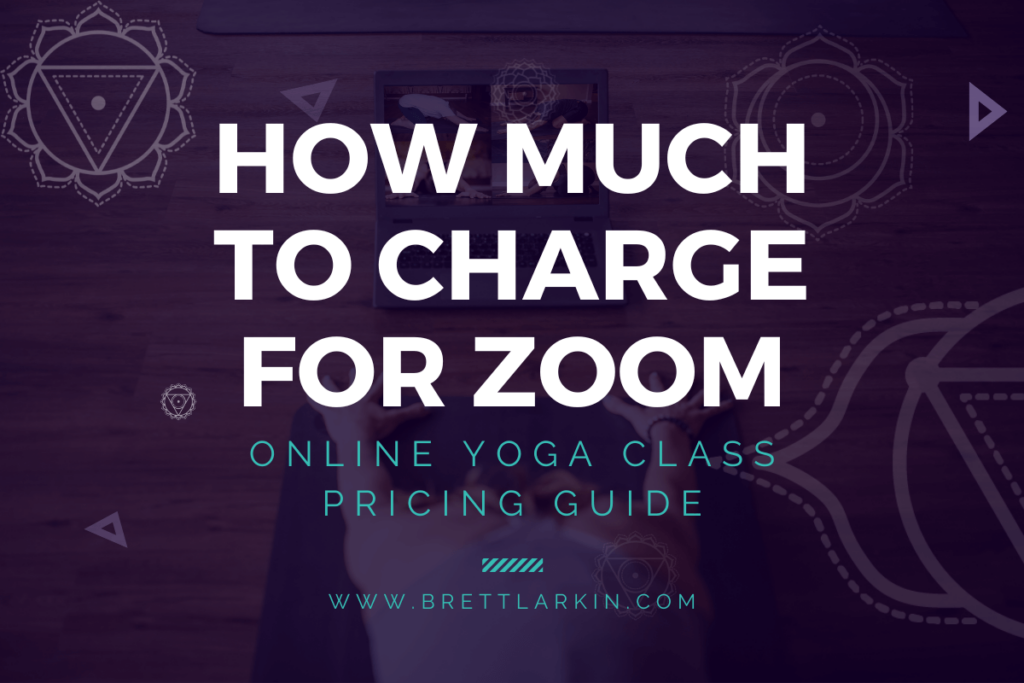When it comes to how much to charge for Zoom yoga class, it can feel tricky to strike the right balance between affordability and value. This is an issue that arises with all online yoga classes.
Luckily, I’ve been teaching online yoga classes for years—and I can help you with setting yoga class prices.
You want to ensure your classes are accessible while also reflecting your expertise and the time you put into creating a meaningful experience.
Think of this like running your own online yoga studio. As a yoga teacher offering classes, you want to ensure you offer a range of yoga sessions with a solid pricing structure.
Whether you’re teaching to a small group private yoga classes (and private yoga clients) or a full virtual studio, understanding the factors that influence your pricing can help you set a fair rate for both you and your students.
Let’s break down the key considerations for how much to charge for your Zoom yoga classes, which will probably help you with other yoga class prices too!
How Much To Charge For a Zoom Yoga Class?
The cost of a Zoom yoga class depends on several factors like your experience, class size, and audience. Online classes typically range anywhere from $10 to 30 per class. However, yoga class prices may be higher for virtual yoga classes if you’re offering private yoga classes or group yoga classes.
Think of this as bringing your yoga studio to the screen. Your yoga classes will still be the same, even as online classes, but you’ll need to differentiate between group yoga classes, private yoga classes, and you might even want to offer free classes, so people can experience what you’re like as a yoga teacher.
Beginners may start at the lower end of the spectrum to attract clients, while a more experienced yoga teacher – or those offering specialized classes – can confidently charge higher rates.
If you’re offering private one-on-one sessions, rates often range from $50 to $150, reflecting the personalized attention and customization. Each yoga class costs a different amount. And you can build a pricing structure that includes private lessons, group lessons, unlimited classes, or even partnering with other wellness practitioners. The options are limitless.
I encourage every yoga teacher to think beyond just the numbers when it comes to online classes. Your rate isn’t just a reflection of the class length—it’s about the value you’re offering.
Consider factors like your preparation time for online classes, the unique expertise you bring as a yoga teacher, and the added convenience of virtual classes, where no one has to trek to an in-person yoga studio.
Your yoga class costs might be higher if you have a unique teaching style. Your pricing strategy might include working with other yoga teachers or cultivating a sacred at-home studio space.
Or maybe you want to structure packages online to include input from personal trainers, gym coaches, and other qualified instructors too, along with your online training. There are so many ways to learn yoga.
For instance, are you incorporating meditation, tailored sequences, or props into your sessions? Many teachers do this without charging a fair price for the added benefits.
Highlight these benefits when setting your price, as they enhance the overall experience for your students.
Additionally, don’t hesitate to experiment with tiered pricing or packages. Your pricing model might include monthly memberships, or a one-time charge for yoga classes for a week.
Offering a discounted rate for bulk class purchases (e.g., $90 for 5 classes) can incentivize regular attendance and provide you with a more predictable income. You can also explore options like donation-based classes to attract a broader audience while still generating revenue.
Do your market research and see what works best for you. Many yoga studios spend years experimenting—and most yoga studios revisit their pricing model every year, to ensure they are charging enough for what private yoga lessons cost, or in person classes, and monthly memberships.
Finally, consider your audience and market when setting prices. Are you catering to busy professionals seeking high-value, convenient workouts, or are you building a community with budget-conscious students?
Research what similar instructors in your niche charge and confidently position your rate to reflect the unique value of your Zoom yoga classes. Private yoga lessons cost more than a group restorative yoga practice.
A yoga class costs a certain amount based on what is delivered and the overall experience. Many yoga teachers create a menu of options for students to choose from. Private yoga sessions might supplement what you make from group yoga lessons.
Build in space in your calendar for private sessions and in person classes too, if that’s something you like to do as a yoga teacher. Yoga retreats and yoga teacher training usually are on the highest tier of your pricing strategy.
Factors That Impact Pricing for Online Yoga Classes
When determining how much to charge for online yoga classes, several key factors come into play, from your target audience to the type of class you offer.
Cost of living, demand for yoga in your area or niche, and the expenses tied to teaching online all affect your pricing structure. Yoga instructors all take different approaches when it comes to pricing strategy.
Whether you’re offering group classes, private sessions, or corporate yoga wellness programs, understanding these variables will help you set competitive rates while ensuring your efforts are fairly compensated. Many yoga instructors are unclear on how to charge for a yoga class.
I want to help you know exactly what to charge for a yoga session, so you can teach yoga with ease and offer a high benefit to your yoga students.
Let’s talk about the variables many yoga teachers need to consider when deciding what to charge for a yoga class and various types of yoga lessons…
Remember other yoga studios might do things differently—and that’s okay! Maybe a teacher only does 3 poses per class and offers that for free.
Maybe another yoga teacher takes weeks curating just the right combination of yoga poses, even adding in a little aerial yoga!
By taking the following factors into consideration, you’ll be sure to price your online yoga classes in a way that’s perfect for you and your students.
Cost of living and demand for classes
Your target audience plays a significant role in determining your pricing. For example, if you’re teaching clients in high-cost-of-living areas or catering to a niche group like busy executives or prenatal yoga enthusiasts, you can typically charge more.
However, students in more budget-conscious communities may expect lower rates, though you can offset this with larger class sizes or donation-based pricing.
Researching local and virtual market trends will help you find a price point that resonates with your audience and reflects the demand for your specific offerings.
Costs of teaching yoga online
Teaching yoga online involves more than just showing up on Zoom. Consider expenses like high-speed internet, a quality camera and microphone, studio lighting, software subscriptions (e.g., Zoom Pro or scheduling apps), and marketing costs to promote your classes.
If you invest in on-demand content or a professional website, these expenses add up and should be factored into your pricing. Setting your rates to cover these costs ensures your yoga business remains sustainable.
Type of online yoga class
The type of class you offer also heavily influences pricing. Group classes generally cost less per student ($10-$30) because multiple participants share the cost. P
rivate sessions, where students receive tailored attention and personalized instruction, warrant higher rates ($50-$150 or more).
Corporate yoga classes, often aimed at promoting employee wellness, can command premium pricing since they typically involve larger budgets and repeat bookings.
Tailoring your rates to the format and audience ensures you’re charging appropriately for the value you provide.
Take my quiz to find out which YTT is best for you:
How To Price Your Online Yoga Class
Pricing your online yoga classes can feel like a daunting task, but with the right strategy, it can also be a fulfilling way to ensure that you’re being compensated fairly for your expertise and time.
Pricing involves not only considering the value of your offerings but also ensuring your services are accessible to your students.
The key is to strike a balance between making your classes affordable for students while ensuring that you’re making a sustainable income.
Here are a series of considerations that will guide you through the process of determining the best pricing structure for your online yoga business.
1. Assess Your Experience and Expertise
One of the most significant factors in setting your price is your level of experience as a yoga instructor.
The more experience you have, the more value you bring to your classes. If you’ve been teaching for several years and have accumulated specialized certifications or experience in particular types of yoga (such as prenatal, restorative, or yoga therapy), you have earned the right to charge more.
Expertise and certifications make you a sought-after teacher, and your knowledge adds value to the experience you offer. As your credentials increase, you should adjust your pricing accordingly.
Additionally, if you’ve built a strong personal brand or have gained a loyal following, this can justify charging premium rates.
Having an established reputation or niche focus—such as being an expert in a particular style of yoga or having a unique approach—makes you stand out in a crowded market and can significantly affect the price you set for your online classes.
2. Understand Your Target Audience’s Budget
While your experience and qualifications play a crucial role in pricing, it’s just as important to understand your audience. Your students’ budgets and their willingness to pay for yoga classes will impact what you charge.
If your audience is made up of individuals who are new to yoga, younger professionals, or those in lower-income brackets, a more affordable price point may be necessary to attract and retain them.
On the other hand, if you’re targeting a corporate crowd, wellness-focused professionals, or a more affluent demographic, you may be able to charge higher rates for your classes.
Understanding their income level and financial priorities helps you tailor your pricing in a way that keeps your classes accessible to your ideal clients while ensuring you’re making a sustainable income.
Consider offering sliding scale rates or packages that appeal to varying income levels, such as discounted rates for students, seniors, or low-income families.
3. Research the Market and Competitors
Before setting your prices, it’s important to understand what other yoga teachers or online yoga platforms are charging.
Conduct some research into the rates of other instructors offering similar content, whether they’re teaching a particular style of yoga or targeting the same geographic area or demographic.
Understanding the market will allow you to position your pricing competitively.
While pricing may vary by location, you can also research the range of prices for online classes or virtual memberships across the board. Keep in mind that your unique selling proposition (USP)—such as an innovative style, a more personalized experience, or exceptional teaching methods—can allow you to charge higher prices than others in the market.
Still, it’s essential to ensure that your pricing is in line with industry standards to remain competitive.
4. Consider Your Class Length and Content
The duration and content of your class will also influence your pricing. Shorter classes, such as a 30-minute session, will typically cost less than a 60 or 90-minute class.
Additionally, if you offer specialized classes, such as those focusing on advanced poses, injury prevention, or emotional healing, you may want to charge more. Specialized content requires additional training and expertise, which warrants higher rates.
A simple general yoga flow may be priced lower compared to a masterclass or workshop where you delve deep into a specific aspect of yoga, such as breathwork, meditation, or alignment techniques.
Workshops and longer classes should be priced accordingly to reflect the extra preparation and specialized focus that goes into them.
Offering a range of class lengths and pricing tiers can provide flexibility for your students while allowing you to target various types of consumers.
5. Choose Between Per-Class, Subscription, or Package Pricing
There are several different pricing structures you can choose from, each with its own set of benefits.
One common model is charging a per-class rate, where students pay for each class they take. This is a great option for those who are just starting with yoga or those who prefer flexibility in their schedules.
However, if you’re looking for more predictable and recurring income, a subscription model or package deal may work better.
A subscription-based model allows you to create a steady stream of income by offering unlimited access to your classes for a monthly fee. This works well for students who want to commit to their practice and engage with your content regularly.
Alternatively, you can offer a package deal, where students pay upfront for a certain number of classes, such as 10 or 20 sessions, at a discounted rate. Packages encourage commitment and often create a sense of community among students.
Choosing the right model depends on the preferences of your students and your own business goals. Some instructors choose to offer a combination of per-class, subscription, and package pricing to cater to a variety of clients. There are so many ways to take payments.
6. Factor in Additional Costs and Expenses
When pricing your classes, it’s essential to account for any additional costs and expenses you incur in running your online business. These may include the cost of a video conferencing platform, a website or membership platform, equipment, marketing, and other operational costs.
You need to factor in these costs when determining your prices so that your classes remain profitable.
For example, if you invest in high-quality camera equipment or hire a videographer for production, these costs should be considered when pricing your classes. Similarly, if you use a subscription-based video hosting platform or pay for advertising to attract students, those costs should be reflected in your pricing structure.
You want to ensure that your classes cover not just your time, but also the tools and services that help make your classes professional and accessible.
7. Test and Adjust Your Pricing Regularly
Pricing isn’t set in stone, and it’s important to stay flexible and adjust as needed. The demand for your online yoga classes may fluctuate based on the season, trends in wellness, or changes in your target market’s preferences. It’s a good idea to regularly review your pricing to ensure it’s still aligned with both your business goals and the value you’re providing.
Test different pricing strategies, and keep an eye on how your students respond. If you notice a drop in attendance or subscriptions after raising prices, it may be time to rethink your approach. Likewise, if your classes are in high demand, you might find that you’re underpricing your services and could raise rates to reflect the value you provide.
The beauty of online yoga classes is the ability to pivot and make changes based on the needs of your students and the market.
8. Offer Discounts and Promotions
To attract new clients or encourage repeat business, offering occasional discounts or promotions can be an effective strategy. You could offer first-time student discounts, bundle deals for multiple classes, or seasonal promotions to entice students to try your classes.
Discounts and promotions can be an excellent way to build trust and show appreciation for loyal students while bringing in new ones.
However, it’s crucial to offer promotions without devaluing your service. Rather than discounting your classes too often, consider adding value in other ways—such as providing additional content or a free downloadable guide or offering a free introductory class to give potential clients a taste of what you offer.
9. Be Transparent with Your Pricing
Lastly, being transparent about your pricing is crucial for building trust with your students. Make sure your students understand exactly what they’re paying for, whether it’s a one-time class, a subscription, or a package deal. Clearly communicate any terms, such as cancellation policies or refund options, and avoid any hidden fees or unclear terms.
Transparency ensures that students don’t feel misled and builds a positive relationship with your audience. When your students feel they are getting value for the price they’re paying, they are more likely to stay loyal and recommend your classes to others.
Final Thoughts
Pricing your online yoga classes doesn’t have to be complicated, but it does require careful consideration.
By evaluating your experience, understanding your target audience, researching the market, and considering your costs, you can establish a pricing structure that benefits both you and your students. Regularly review your pricing strategy to ensure it reflects the value you offer and is aligned with market trends.
Ultimately, the right price will allow you to maintain a sustainable yoga business while providing valuable services that help your students grow in their practice.
Next Steps
Fall in Love with 300-Hour Yoga Teacher Training
If you’re ready to go deeper and make a full-time living from your teaching business, then this training might be for you.

Sneak Peak into My 300-Hour YTT - FREE Videos, Info Session, Bonuses!

The Uplifted 300/500-Hour YTT is the first and only program in the yoga industry to combine:
- Master’s-Level Yoga Training
- Business Coaching
- High End Mastermind
As a yoga instructor, you’ll receive everything you need to grow and scale your business. You’ll learn how to run your first event, a retreat, how to build your site, and so, so much more. Get started here!
Additional Resources
- Learn how to ask for a raise at your yoga studio.
- Explore my Yoga Teacher Resource knowledge hub for more tips about how to grow your yoga business.
- Download my sequences for a jumpstart on your upcoming yoga classes!
- For more detailed tips, processes, and worksheets to supercharge your yoga business, download my yoga business launchpad course!
YOU MIGHT ALSO LIKE
- Somatic Yoga Workshop Ideas for Teachers
- Somatic Yoga For Yoga Teachers: Everything You Need to Know in 10 Steps
- How to Teach Somatic Yoga: A Practical Guide for Instructors
- How Much to Charge for Zoom Yoga Class: A Practical Pricing Guide
- Comprehensive Guide to Your Yoga Service Agreement
- How To Create Mindful Somatic Yoga Sequences Your Students Will Love
- What Is Mindset Coaching? A Complete Breakdown
- 5 Affordable Yoga Teacher Insurance Plans (Updated 2024)
- How To Make A Life Coaching Intake Form
- 7 Steps To Start A Life Coaching Business
- What Is A Self Love Coach? And How To Become One
- Self-Coaching: How To Become Your Own Life Coach
- Types Of Life Coaches: How To Choose Your Life Coaching Niche
- 20 Awesome Ways To Make Money As A Yoga Instructor
- Life Coach Marketing: A Comprehensive Guide For Long-Term Growth






















